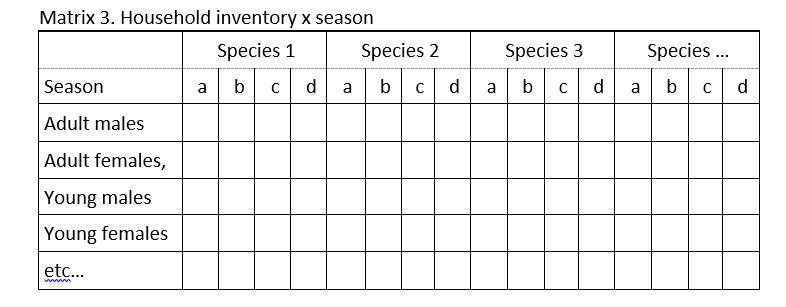You are here
Herd Composition
The composition of the herd can be indicative of the production objective and the productivity of the herd. A study in Botswana (Behnke 1987) found that commercially oriented herds had fewer oxen (which are prime animals for selling for meat) than herds used primarily for accumulation (whether as insurance or as a cultural priority). That study found herd composition to be a better indicator of commercialization than net sales because of the frequency of emergency sales when crops failed. In Western Kenya, there is a focus on dairy production and so cows form a large portion of the herd, whereas in the Ethiopian Rift Valley draft power is a key service and oxen are more numerous than cows (Baudron et al. 2014). A detailed study of Maasai herd compositon (de Leeuw et al. 1991) showed that larger herds had higher heifer to cow ratios and calf to cow rations, which show they are growing the fastest. Small herds either had lower reproductive success or the owners were prioritizing selling young females over growing their herd.
How to operationalize the metric
Method of data collection and data needed to compute the method:
The following method to collect data on herd composition is an excerpt from “A guide to indicators and methods for assessing the contribution of livestock keeping to livelihoods of the poor” by Dorward et al. (2005).
Household animal inventory (copied from Dorward et al. 2005, p.17)
Purpose: to identify in more detail the herd or flock structure and composition for each livestock species and significant changes over the year, to gain greater understanding of livestock keeping activities. (note: The collection of livestock numbers by species, sex and age provides data that can also be used to estimate a limited number of quantitative production parameters such as fertility rates and some information on age at first calving, lambing or sowing. There is also the possibility of making some very simple estimates on the value of investment in livestock and their generation of income. Simple production parameters can also be used in herd models to develop ideas on production and productivity (for further references see Dorward et al. 2005).
Contribution: Determination of beneficiaries’ current assets, activities, priorities & options in livestock keeping
Activity: Construct a matrix showing the flock/ herd composition for each species kept. Ranges of numbers kept can be related to parts of the year to show seasonal variation (Matrix 3).
 Method: List the species kept by the household in columns and major classes in rows. In each cell note down the number of animals kept. To capture seasonal variation it may be necessary to draw up a separate table for different seasons, to note down in each cell particular seasonal events or changes, or to draw different sub-columns for each species to represent inventory changes between different times of year. The matrix layout above uses this approach, allowing for four different seasonal periods in the year.
Method: List the species kept by the household in columns and major classes in rows. In each cell note down the number of animals kept. To capture seasonal variation it may be necessary to draw up a separate table for different seasons, to note down in each cell particular seasonal events or changes, or to draw different sub-columns for each species to represent inventory changes between different times of year. The matrix layout above uses this approach, allowing for four different seasonal periods in the year.
Unit of analysis:
The unit of analysis is the household/farm livestock.
Limitations regarding estimating and interpreting:
This metric may be difficult to estimate at the community level when livestock ownership is concentrated among a few farmers. Interpreting the meaning of changes in herd composition requires in-depth knowledge of the context and driving forces behind farmers’ behaviors. The data collected from the animal inventory can be complemented by qualitative information from interviews or focus group discussions inquiring about the uses of each type of animal and farmers’ reasoning for changes in herd composition.

